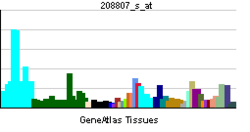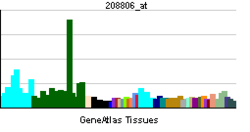CHD3
Chromodomain-helicase-DNA-binding protein 3 is an enzyme that in humans is encoded by the CHD3 gene.[1][2][3]
This gene encodes a member of the CHD family of proteins which are characterized by the presence of chromo (chromatin organization modifier) domains and SNF2-related helicase/ATPase domains. This protein is one of the components of a histone deacetylase complex referred to as the Mi-2/NuRD complex which participates in the remodeling of chromatin by deacetylating histones. Chromatin remodeling is essential for many processes including transcription. Autoantibodies against this protein are found in a subset of patients with dermatomyositis. Three alternatively spliced transcripts encoding different isoforms have been described.[3]
Interactions
CHD3 has been shown to interact with HDAC1,[4][5] Histone deacetylase 2[4][6][7] and SERBP1.[8][9]
References
- ↑ Woodage T, Basrai MA, Baxevanis AD, Hieter P, Collins FS (November 1997). "Characterization of the CHD family of proteins". Proc Natl Acad Sci USA 94 (21): 11472–7. doi:10.1073/pnas.94.21.11472. PMC 23509. PMID 9326634.
- ↑ Ge Q, Nilasena DS, O'Brien CA, Frank MB, Targoff IN (November 1995). "Molecular analysis of a major antigenic region of the 240-kD protein of Mi-2 autoantigen". J Clin Invest 96 (4): 1730–7. doi:10.1172/JCI118218. PMC 185809. PMID 7560064.
- ↑ 3.0 3.1 "Entrez Gene: CHD3 chromodomain helicase DNA binding protein 3".
- ↑ 4.0 4.1 Tong, J K; Hassig C A; Schnitzler G R; Kingston R E; Schreiber S L (October 1998). "Chromatin deacetylation by an ATP-dependent nucleosome remodelling complex". Nature (ENGLAND) 395 (6705): 917–21. doi:10.1038/27699. ISSN 0028-0836. PMID 9804427.
- ↑ Kuzmichev, A; Zhang Y; Erdjument-Bromage H; Tempst P; Reinberg D (February 2002). "Role of the Sin3-Histone Deacetylase Complex in Growth Regulation by the Candidate Tumor Suppressor p33ING1". Mol. Cell. Biol. (United States) 22 (3): 835–48. doi:10.1128/MCB.22.3.835-848.2002. ISSN 0270-7306. PMC 133546. PMID 11784859.
- ↑ Hakimi, Mohamed-Ali; Dong Yuanshu; Lane William S; Speicher David W; Shiekhattar Ramin (February 2003). "A candidate X-linked mental retardation gene is a component of a new family of histone deacetylase-containing complexes". J. Biol. Chem. (United States) 278 (9): 7234–9. doi:10.1074/jbc.M208992200. ISSN 0021-9258. PMID 12493763.
- ↑ Hakimi, Mohamed-Ali; Bochar Daniel A; Schmiesing John A; Dong Yuanshu; Barak Orr G; Speicher David W; Yokomori Kyoko; Shiekhattar Ramin (August 2002). "A chromatin remodelling complex that loads cohesin onto human chromosomes". Nature (England) 418 (6901): 994–8. doi:10.1038/nature01024. ISSN 0028-0836. PMID 12198550.
- ↑ Lemos, Taíla A; Passos Dario O; Nery Flávia C; Kobarg Jörg (January 2003). "Characterization of a new family of proteins that interact with the C-terminal region of the chromatin-remodeling factor CHD-3". FEBS Lett. (Netherlands) 533 (1–3): 14–20. doi:10.1016/S0014-5793(02)03737-7. ISSN 0014-5793. PMID 12505151.
- ↑ Stelzl, Ulrich; Worm Uwe, Lalowski Maciej, Haenig Christian, Brembeck Felix H, Goehler Heike, Stroedicke Martin, Zenkner Martina, Schoenherr Anke, Koeppen Susanne, Timm Jan, Mintzlaff Sascha, Abraham Claudia, Bock Nicole, Kietzmann Silvia, Goedde Astrid, Toksöz Engin, Droege Anja, Krobitsch Sylvia, Korn Bernhard, Birchmeier Walter, Lehrach Hans, Wanker Erich E (September 2005). "A human protein-protein interaction network: a resource for annotating the proteome". Cell (United States) 122 (6): 957–68. doi:10.1016/j.cell.2005.08.029. ISSN 0092-8674. PMID 16169070.
Further reading
- Bowen NJ, Fujita N, Kajita M, Wade PA (2004). "Mi-2/NuRD: multiple complexes for many purposes". Biochim. Biophys. Acta 1677 (1–3): 52–7. doi:10.1016/j.bbaexp.2003.10.010. PMID 15020045.
- Gieser L, Swaroop A (1992). "Expressed sequence tags and chromosomal localization of cDNA clones from a subtracted retinal pigment epithelium library". Genomics 13 (3): 873–6. doi:10.1016/0888-7543(92)90173-P. PMID 1639417.
- Seelig HP, Moosbrugger I, Ehrfeld H et al. (1995). "The major dermatomyositis-specific Mi-2 autoantigen is a presumed helicase involved in transcriptional activation". Arthritis Rheum. 38 (10): 1389–99. doi:10.1002/art.1780381006. PMID 7575689.
- Seelig HP, Renz M, Targoff IN et al. (1996). "Two forms of the major antigenic protein of the dermatomyositis-specific Mi-2 autoantigen". Arthritis Rheum. 39 (10): 1769–71. doi:10.1002/art.1780391029. PMID 8843877.
- Bonaldo MF, Lennon G, Soares MB (1997). "Normalization and subtraction: two approaches to facilitate gene discovery". Genome Res. 6 (9): 791–806. doi:10.1101/gr.6.9.791. PMID 8889548.
- Aubry F, Mattéi MG, Galibert F (1998). "Identification of a human 17p-located cDNA encoding a protein of the Snf2-like helicase family". Eur. J. Biochem. 254 (3): 558–64. doi:10.1046/j.1432-1327.1998.2540558.x. PMID 9688266.
- Tong JK, Hassig CA, Schnitzler GR et al. (1998). "Chromatin deacetylation by an ATP-dependent nucleosome remodelling complex". Nature 395 (6705): 917–21. doi:10.1038/27699. PMID 9804427.
- Kleiderlein JJ, Nisson PE, Jessee J et al. (1999). "CCG repeats in cDNAs from human brain". Hum. Genet. 103 (6): 666–73. doi:10.1007/s004390050889. PMID 9921901.
- Kim J, Sif S, Jones B et al. (1999). "Ikaros DNA-binding proteins direct formation of chromatin remodeling complexes in lymphocytes". Immunity 10 (3): 345–55. doi:10.1016/S1074-7613(00)80034-5. PMID 10204490.
- Wade PA, Gegonne A, Jones PL et al. (1999). "Mi-2 complex couples DNA methylation to chromatin remodelling and histone deacetylation". Nat. Genet. 23 (1): 62–6. doi:10.1038/12664. PMID 10471500.
- Cousin P, Billotte J, Chaubert P, Shaw P (2000). "Physical map of 17p13 and the genes adjacent to p53". Genomics 63 (1): 60–8. doi:10.1006/geno.1999.6062. PMID 10662545.
- Minty A, Dumont X, Kaghad M, Caput D (2000). "Covalent modification of p73alpha by SUMO-1. Two-hybrid screening with p73 identifies novel SUMO-1-interacting proteins and a SUMO-1 interaction motif". J. Biol. Chem. 275 (46): 36316–23. doi:10.1074/jbc.M004293200. PMID 10961991.
- Schultz DC, Friedman JR, Rauscher FJ (2001). "Targeting histone deacetylase complexes via KRAB-zinc finger proteins: the PHD and bromodomains of KAP-1 form a cooperative unit that recruits a novel isoform of the Mi-2α subunit of NuRD". Genes Dev. 15 (4): 428–43. doi:10.1101/gad.869501. PMC 312636. PMID 11230151.
- Yasui D, Miyano M, Cai S et al. (2002). "SATB1 targets chromatin remodelling to regulate genes over long distances". Nature 419 (6907): 641–5. doi:10.1038/nature01084. PMID 12374985.
- Strausberg RL, Feingold EA, Grouse LH et al. (2003). "Generation and initial analysis of more than 15,000 full-length human and mouse cDNA sequences". Proc. Natl. Acad. Sci. U.S.A. 99 (26): 16899–903. doi:10.1073/pnas.242603899. PMC 139241. PMID 12477932.
- Lemos TA, Passos DO, Nery FC, Kobarg J (2003). "Characterization of a new family of proteins that interact with the C-terminal region of the chromatin-remodeling factor CHD-3". FEBS Lett. 533 (1–3): 14–20. doi:10.1016/S0014-5793(02)03737-7. PMID 12505151.
- Fujita N, Jaye DL, Kajita M et al. (2003). "MTA3, a Mi-2/NuRD complex subunit, regulates an invasive growth pathway in breast cancer". Cell 113 (2): 207–19. doi:10.1016/S0092-8674(03)00234-4. PMID 12705869.
- Lee BH, Yoshimatsu K, Maeda A et al. (2004). "Association of the nucleocapsid protein of the Seoul and Hantaan hantaviruses with small ubiquitin-like modifier-1-related molecules". Virus Res. 98 (1): 83–91. doi:10.1016/j.virusres.2003.09.001. PMID 14609633.

